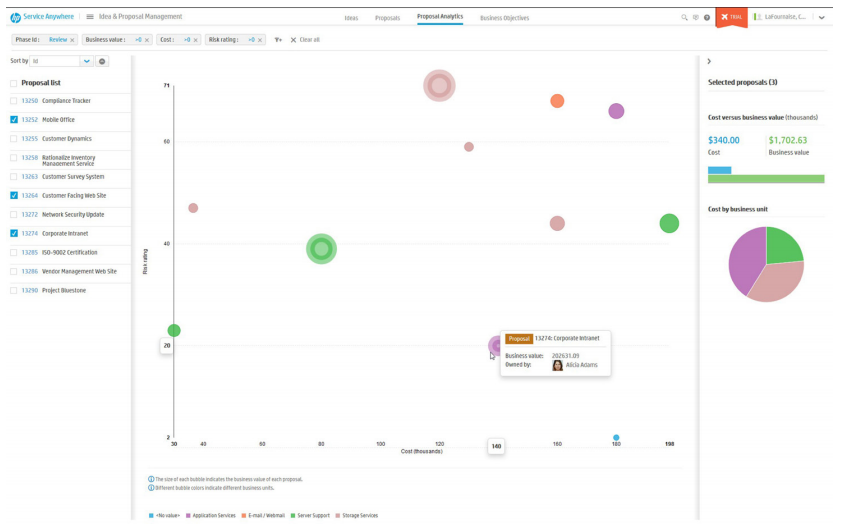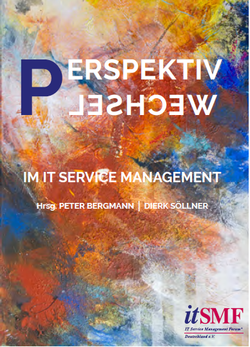5 answers for user-focused and demand-oriented support processes
It is a fact that cloud computing changes the IT landscape in companies. This is especially true as the focus in IT Service Management (ITSM) shifts away from pure IT operations related support processes. New customers of traditional IT departments are increasingly non-IT user departments. As a result of this shift, IT support processes have become user-focused and demand-oriented.
Due to the increasing usage of standardized, automated cloud services—instead of individualized IT services—the traditional and operational composition of incident, problem and change management has lost its importance. Companies are now facing the challenges of transferring the cloud principle to their ITSM.
Since the introduction of the IT Infrastructure Library (ITIL) 30 years ago, traditional ITSM has mainly focused on incident management, problem and change management. The third version is now used by nearly all companies and is considered the de-factor standard. The focus has been on:
- Incident management deals with the resolution of incidents
- Problem management analyzes the causes of recurring incidents
- Change management relates to changes in the IT landscape
Hewlett Packard Enterprise has long followed a strategic approach to align the flagship service desk software, HPE Service Manager ITSM suite with today’s de-facto standard ITIL®. Hewlett Packard Enterprise has been an active supporter of ITIL® since 1995 and has been a leading driver in the refresh of the ITIL® Version 3. HPE consultants authored one of the five core books of the library, titled “Service Operation”. The team also authored flow charts and the ITIL® v3 Glossary.
The increasing use of cloud services (private cloud, public cloud services, or a combination of both in hybrid cloud environments) sets new challenges for IT departments: They have to manage cloud services in addition to traditional on-premise infrastructures.
There are two types of ITSM solutions: on-premise and SaaS. You can also utilize an approach for a hybrid environment, as described in my previous blog, ‘6 Tips for a successful hybrid ITSM strategy.
Two years ago, Hewlett Packard Enterprise introduced HPE Service Anywhere, a pure SaaS service desk as an answer to the cloud. The latest September release sets new standards. You can learn more about the September release in this blog, Jazz up your September with the newest release of HP Service Anywhere!
From company-focused to user-focused IT support
The changing IT infrastructure requires a paradigm shift in ITSM. In addition to the above I see three other drivers at play in this scenario. The drivers that make companies rethink their strategy are: the increasing the speed with which user departments’ demand new IT services, increasing skill shortages with fewer experts who can manage the IT landscapes, and increasing cost pressures in IT. For these reasons, companies have to increasingly standardize and automate IT services.
In ITSM, the focus shifts from traditional IT support processes to cloud support processes. Instead of simply looking at company-focused processes for incidents, problems, changes, and maybe even configurations, other processes now have a higher priority:
- Service request management: How are service requests and approvals processed via a self-service portal?
- Service catalog management: How is the service catalog structured and which services are supposed to be provided?
- Service level management: Which quality standards are used to measure the services?
- Financial management: How are the services financed? How can financial management be used as a corrective approach to avoid the problems from employees always ordering the most cost-intensive services even though less expensive ones would be sufficient?
- Knowledge management: Which services provide additional features, functions, and requirements? How can users retrieve the respective information?
What does the above mean to your ITSM solution? How do you approach these processes from a tools perspective? Here are …
5 answers for user-focused and demand-oriented support processes
Hewlett Packard Enterprise has an answer to the questions above by integrating two products, HPE Service Manager and HPE Service Anywhere. This collaboration considers the newly focused processes or ITIL® disciplines. Additional products, such as HPE Propel, provide a comprehensive and central (aggregated) service catalog—via the cloud in order to equip companies with clear priorities and added value.
1. Service request management
A specific management module enables you to record, approve, and process service requests. A distinction is made between service requests and incidents to separate tickets with regard to evaluations and in conformity with ITIL®. Product-specific self-service portals enable users to address their requirements and obtain integrated support.
A service request can be a request for information, for a consultation, or for the provisioning of standardized IT services. However, the trend is clearly contrary to the traditional concept of a service request.
For example, the number of incidents in companies has nearly remained the same over the last few years, despite the increasing usage of complex systems with considerably more interfaces and significantly larger data volumes. One of the reasons for this stability, is the usage of more sophisticated technologies and the increased power of control tools that monitor the systems.
By being able to better control technology, IT services can now be provided with:
- Higher quality
- Fewer interruptions
- More speed
- A broader scope of functions than in the past
In some cases, the number of incidents even decreases. One thing to note, this is in contrast to service requests. Here, the number increases, because new services are constantly added to the catalog and made available to users.
2. Service catalog management
A specific management module enables you to create and manage catalog items and make them available via the self-service portal. Basically, the service catalog is the hallmark of the IT and also of non-IT areas, such as HR or Facility Management.
This is also a trend in the ITSM area and is described in detail in the ‘Trends in IT Service Management: What does the future hold?’ blog and survey.
3. Service Level Management (SLM)
The service level management module of the two ITSM suite solutions acts in the background and monitors the defined Service Level Agreements (SLA).
A manifested IT governance is essential for SLM and is one of the most important challenges for the management of contracts and the corresponding SLAs. IT governance should be linked with the controlling units of the providers and support units. This includes central contract, risk and service level management to clarify interface and process issues as well as defined reporting to minimize risks. Based on the ITIL® processes, the CoBIT control catalog may be helpful.
The SLM module has been developed according to IT governance requirements and is an integral part of further modules and ITIL disciplines, such as service desk, service request, incident, problem or change management.
4. Financial management
HPE Service Anywhere has a specific management module for financial management. The module enables you to create, assign, and manage assets, cost centers, and cost types. You can efficiently manage (IT) costs in order to follow the company’s strategy and achieve the defined business goals. Furthermore, you can manage the budget by implementing, monitoring, and controlling financial resources respectively. It also enables you to simulate assets according to fictitious criteria for the company’s future orientation on the basis of business goals in order to visualize a differentiated and financial perspective.
The video ‘Financial Management and Net Value Simulation overview’ [LK1] introduces the financial management module in HPE Service Anywhere including a net value simulation.
HPE Service Manager uses the same defined HP Universal CMDB (UCMDB) to collaborate with HPE Asset Manager and provides a very detailed asset and financial management view. In combination with HPE Asset Manager, HPE Service Manager is certainly ideal for large organizations.
However, financial management is an integral part of both ITSM suites and—due to its orientation toward IT services—it is essential and indispensable.
5. Knowledge management
A knowledge management module is essential for both ITSM suite versions. In particular, it enhances and supports the big data environment. I believe that Hewlett Packard Enterprise has a competitive edge over other enterprises, which is also described in the latest G2 Crowd Grid for Service Desk Software survey and rating.
The available self-service portal integrates and provides knowledge content via the management modules. The big data edition supports knowledge management in order to identify solutions and support services easily and efficiently and provides feedback in reports.
Other management disciplines
Of course, numerous answers and situations can be added to these five answers. For example, the last HP Service Anywhere release included a stand-alone proposal management module. In the new September release, the new application portfolio management module provides support for the service lifecycle.
- Proposal management
Proposal management follows a crowd-sourcing approach to gather ideas to better integrate employees, solutions, developments of new services, and innovations via the user community of the ITSM suite. It is vital to integrate employees etc. with the business processes and to actively involve users in the company to give a sense of an “entrepreneur in the enterprise.” This has the advantage that employees are asked, feel appreciated and thus contribute to the company’s success based on these incentives—in addition to adding the value of good ideas.

- Application portfolio management
The new Application Portfolio Management (APM) module enhances and supports the service lifecycle in HPE Service Anywhere and allows companies to understand the context of the applications that they use in services.

The APM overview and detail content support managers in the company in order to enhance the portfolio, adapt the roadmap to the application portfolio, and determine which applications should be outsourced to the cloud.
Change in perspective
Changing from company-focused to user-focused IT support helps you achieve and further extend the described paradigm shift. A change in perspective accompanies, supports, and helps you during the transition phase, including numerous projects, trainings, tool introductions, and continuous adaptations and enhancements of the ITSM-related processes, and beyond.
As the co-author of the book “Perspektivwechsel im IT Service Management” I want to recommend this collection of stories of more than 30 authors published by the German IT Service Management Forum, itSMF Deutschland e.V.
The book is a light, informal, ironic—but not sarcastic—collection of experiences which, among other things, prevent you from making the same mistakes. The stories range from true-to-life, real, ideal to fictitious and the book includes personal thoughts, off-topic notes, or lessons learned as well as tips and tricks.
The book is written from a different perspective and currently available at Amazon in German and is really fun to read.





